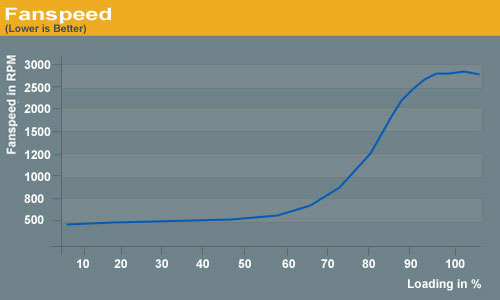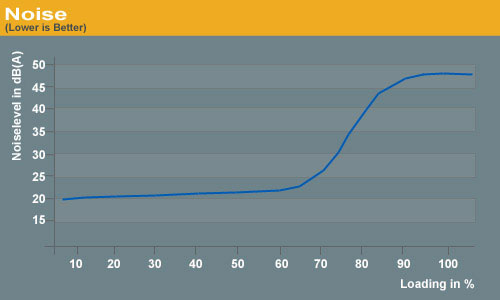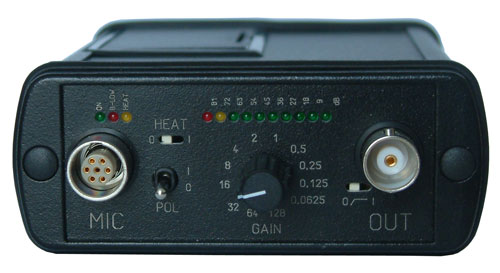AnandTech Power Supply Test Methodology
by Christoph Katzer on July 12, 2007 12:00 AM EST- Posted in
- Cases/Cooling/PSUs
Fan Speed and Resulting Sound Pressure Level (SPL)
The fan speed and the actual temperature of the heatsinks are completely dependent on each other. If the fan(s) turn slowly the heat inside of the power supply will increase as there will be a lack of heat dissipation from the heatsinks. However, the sound pressure level will drop. Conversely, if the fan speed increases the temperatures get better inside the power supply, because the airflow helps to dissipate the heat. The difficulty comes in balancing the desire for lower temperatures with a competing desire for lower noise levels.
Some companies use slower rotating fans in their power supplies to promote quiet/silent products; unfortunately, they don't mention anything about heat levels that can increase tremendously. The fan of the power supply is not only there to cool down the unit itself but also to help exhaust air from the PC. If you have a very slow rotating fan installed the heat of the system will increase, which increases the heat in the power supply as well. The result is a generally hotter system - hotter CPUs, GPUs, hard drives, memory, etc. - and a very sweaty power supply with drooping DC voltages. This, incidentally, is one of the advantages OEM PCs have over their DIY siblings: the OEM is in control of all aspects of the system, and thus is able to determine an optimal configuration of fans, PSU, etc. The best custom-built PCs should take a similar approach, and simply looking for silence without regards to temperatures can lead to unwanted results.
Companies that promote silent power supplies need to have a very good architecture for the printed circuit board and very high-quality components on it. If they skimp in either area, the components are certain to fail at some point. A good indication of a PSU that generates less heat is the stated efficiency. The more efficient a power supply is working, the less heat will need to be dissipated through the coolers. A few years ago such high-quality designs were uncommon at best but companies wanted to have silent power supplies. The result was that most of the units failed after a short time because of overheating.
The art each company needs to master is running the fan speed at an acceptable noise level. There are companies that don't say a word about it and others which stick to their policy that a healthy power supply is a cooled power supply. One of the latter companies is Enermax which says that they know they don't have the quietest power supplies because they prefer the fan(s) to cool the unit to a level that prevents heat-related failures. The user can be sure whey will get very good heat dissipation, but they will also need to get used to increasing noise levels when fully loaded.
To get an impression of how the fan contributes to the cooling of the power supply as well as the resulting noise levels we will test several features. First we measure the actual fan speed in rotations per minute (RPM). This is done with our digital RPM measuring instrument that uses a laser to detect the passing of a white dot placed on the blades, and the frequency is then converted into RPMs.

Sample Fanspeed
To measure the produced noise we have build an anechoic room in which we can measure the noise down to just 15 dB(A). There are simply no power supplies (except fanless models) that can reach this level under this sort of test, but at the same time we will be able to differentiate between varying levels of near-silence. In addition to the sound pressure level we will perform a spectrum analysis to show the different levels of noise produced by the fan at various frequencies.

Sample Noise
The Microphone
To get precise measurements of the noise we need something more than your typical headset-microphone. Even with professional microphones there are big differences which can result in a bad reading. There are many kinds of microphones which are totally inappropriate for test measurements of power supplies or other components. Cardioids-type microphones are pretty much useless since they are designed for directional use within a bigger space and not at all for short distances. The only microphones appropriate for these kinds of measurements are free-field microphones.

Our Microphone is a 0.5" free-field condenser measuring capsule from the renowned German specialist Microtech Gefell.

Microtech Gefell is also the manufacturer of our measuring amplifier. It adjusts the dynamic range of the measuring signal to the input dynamic of the connected PC with which we are analyzing the results.
The fan speed and the actual temperature of the heatsinks are completely dependent on each other. If the fan(s) turn slowly the heat inside of the power supply will increase as there will be a lack of heat dissipation from the heatsinks. However, the sound pressure level will drop. Conversely, if the fan speed increases the temperatures get better inside the power supply, because the airflow helps to dissipate the heat. The difficulty comes in balancing the desire for lower temperatures with a competing desire for lower noise levels.
Some companies use slower rotating fans in their power supplies to promote quiet/silent products; unfortunately, they don't mention anything about heat levels that can increase tremendously. The fan of the power supply is not only there to cool down the unit itself but also to help exhaust air from the PC. If you have a very slow rotating fan installed the heat of the system will increase, which increases the heat in the power supply as well. The result is a generally hotter system - hotter CPUs, GPUs, hard drives, memory, etc. - and a very sweaty power supply with drooping DC voltages. This, incidentally, is one of the advantages OEM PCs have over their DIY siblings: the OEM is in control of all aspects of the system, and thus is able to determine an optimal configuration of fans, PSU, etc. The best custom-built PCs should take a similar approach, and simply looking for silence without regards to temperatures can lead to unwanted results.
Companies that promote silent power supplies need to have a very good architecture for the printed circuit board and very high-quality components on it. If they skimp in either area, the components are certain to fail at some point. A good indication of a PSU that generates less heat is the stated efficiency. The more efficient a power supply is working, the less heat will need to be dissipated through the coolers. A few years ago such high-quality designs were uncommon at best but companies wanted to have silent power supplies. The result was that most of the units failed after a short time because of overheating.
The art each company needs to master is running the fan speed at an acceptable noise level. There are companies that don't say a word about it and others which stick to their policy that a healthy power supply is a cooled power supply. One of the latter companies is Enermax which says that they know they don't have the quietest power supplies because they prefer the fan(s) to cool the unit to a level that prevents heat-related failures. The user can be sure whey will get very good heat dissipation, but they will also need to get used to increasing noise levels when fully loaded.
To get an impression of how the fan contributes to the cooling of the power supply as well as the resulting noise levels we will test several features. First we measure the actual fan speed in rotations per minute (RPM). This is done with our digital RPM measuring instrument that uses a laser to detect the passing of a white dot placed on the blades, and the frequency is then converted into RPMs.

Sample Fanspeed
To measure the produced noise we have build an anechoic room in which we can measure the noise down to just 15 dB(A). There are simply no power supplies (except fanless models) that can reach this level under this sort of test, but at the same time we will be able to differentiate between varying levels of near-silence. In addition to the sound pressure level we will perform a spectrum analysis to show the different levels of noise produced by the fan at various frequencies.

Sample Noise
The Microphone
To get precise measurements of the noise we need something more than your typical headset-microphone. Even with professional microphones there are big differences which can result in a bad reading. There are many kinds of microphones which are totally inappropriate for test measurements of power supplies or other components. Cardioids-type microphones are pretty much useless since they are designed for directional use within a bigger space and not at all for short distances. The only microphones appropriate for these kinds of measurements are free-field microphones.

Our Microphone is a 0.5" free-field condenser measuring capsule from the renowned German specialist Microtech Gefell.

Microtech Gefell is also the manufacturer of our measuring amplifier. It adjusts the dynamic range of the measuring signal to the input dynamic of the connected PC with which we are analyzing the results.










49 Comments
View All Comments
sprockkets - Saturday, July 14, 2007 - link
I've used a kill a watt device to test for pfc, seems most computers are around 0.6 to 0.64. My old Shuttle box with a replaced power supply with active pfc gets a 0.95 pfc.Phlargo - Thursday, July 12, 2007 - link
This is an excellent commitment to a quality review methodology which will not only benefit the Anandtech community, but the whole power supply industry if the message here is taken to heart by consumers. That anandtech has decided to actively create a reliable and consistent power supply review rig is just another example of exactly why I have come to this great site for so many years.Great work!
mostlyprudent - Thursday, July 12, 2007 - link
My thoughts exactly!qpwoei - Thursday, July 12, 2007 - link
How fast can you ramp the current on that rig? I'd be very interested to see how PSUs respond to sudden changes in power usage (caused by sudden changes in CPU/GPU load, HDDs spinning up/down, etc).Even if the fancy equipment can't handle it, measuring this shouldn't be too hard with a cheap digital scope and a 20W passive load. Put the probe on the 12V rail to be measured, attach one end of the load to ground, attach the trigger to the high side of the load, then connect the high side of the load to the 12V rail. Should give a nice edge to trigger on. The trick would be connecting the high side fast enough. A switch/relay would probably be too slow, though a bank of MOSFETS should do the job fine. Actually, the current to turn on the MOSFET bank itself would be a good transient test :)
Also, I think a far more interesting thing with respect to temperature is how the PSU reacts to elevated temperatures, as opposed to temperature WRT load. Since a lot of cheaper PSUs are rated at 20 deg C, I'd expect to see them struggling to supply full power at 40 deg C or so. You'd need to regulate the intake air temperature, but that shouldn't be too hard.
JonnyBlaze - Thursday, July 12, 2007 - link
looks like it can do it.
qpwoei - Friday, July 13, 2007 - link
That's the "mains" supply thing. I noticed that you can read the module number in one of the shots, and it appears that the 63103 can do dynamic load tests - 5 A/us slew with adjustable repetition rates should do the job nicely. I'd be really, really interested to see some results from this.ATWindsor - Thursday, July 12, 2007 - link
Hopefully you will be using the box for some other SPL-measurments on equipment that is not a PSU also?AtW
WW2Planes1 - Thursday, July 12, 2007 - link
Great looking setup. (I love the sound isolating box). I Finally feel like I'll actually learn something from a power supply review.I agree with BladeVenom, I really hope to see some midrange/budget PSUs as well as the higher end ones.
One other thing that would be nice to see in reviews (not just the power supply ones), is longer term reliability. Most things (and especially computer components), aren't really built with longevity in mind, and with certain critical components (power supplies, hard drives, etc) it would be nice to know if certain companies build longer lasting products than others. I understand the difficulties involved with something like that, so I don't really expect to see it, but it would be nice.
TA152H - Thursday, July 12, 2007 - link
I'm not sure midrange or budget power supplies are ever a great idea, unless they are just low power units. A couple of times I bought cases with these power supplies, and was just plopping an old motherboard in it so I didn't care too much, and found they are really problematic. They poison everything downstream from them, which is pretty much everything, and they do nothing good for the reliability of the system, and of course greatly reduce the lifespan of it.The one part of system that should never be compromised on is the power supply. A slower processor or video card might work fine for most people, and if it's not fast enough, it's not catastrophic. A poorly made power supply can have catastrophic consequences and whatever money you save on it, it can cost you later on in multiples of it. You can't make a good power supply out of bad components either, so I don't see how a low cost power supply could impress. Even if it did fairly well in their tests, I'd have serious concerns about the reliability and what will happen to it as time goes along. Low cost power supplies can't be using the same high quality parts, after all.
I'm not knocking power supplies that cost a little because they have relatively low power output. I'm saying if you see an 800 watt power supply that is costing 40% less that other quality 800 watt power supplies with the same feature set, you're asking for trouble buying it. You don't roll dice with power supplies.
Still, it might be interesting just to see the differences quantified, between low and high quality power supplies. I just hope it doesn't lead to people buying the low quality junk. That would be a terrible disservice. It's better to save money on ANY other part of the system before the power supply.
mostlyprudent - Thursday, July 12, 2007 - link
When I think of midrange PSUs, I think of lower wattage models (380-450) by reputable vendors. However, as the article mentions, there are a lot of new players popping up in this market. Hopefully that kind of competition is leading to more competative pricing. It may cease to be true that you need to spend over $100 to get a high quality PSU.My point is that there may be some real value to testing less expensive PSUs.
I get the impression from this article that AT will test a wide range of PSUs (from a wattage standpoint). I hope that is the case. There is nothing more frustrating to me than finding reputable review sites who don't have any recomended PSUs below the 700 watt level.